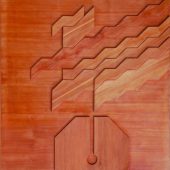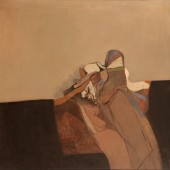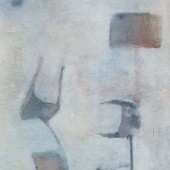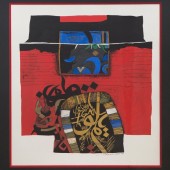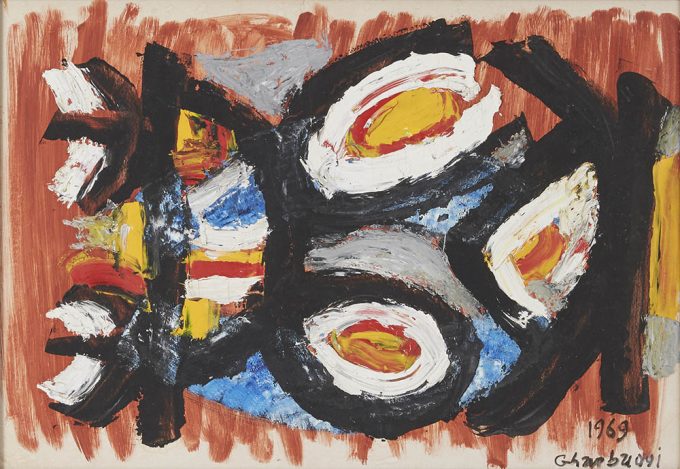
Jilali Gharbaoui was a leading artist of the modernist movement in Morocco. Unlike his contemporaries such as Ahmed Cherkaoui, who grounded their modernist practice in symbols of Moroccan culture, Gharbaoui rooted his abstraction in the materiality of paint and gesture of the brushstroke on canvas. Practicing as both a painter and sculptor, Gharbaoui’s earlier works are relatively representational. His later abstract works, however, such as this 1969 painting, highlight the movement of the brushwork and emphasise the layered, texture of the paint on the canvas. Notice, for instance, the loose red brushstrokes whose linear repetition forms the background and the buildup of paint around the white circular forms. Gharbaoui’s hand is emphasised further by leaving patches of canvas untouched by paint.
Born in 1930 in the Sidi Kacem region of Morocco, Gharbaoui began studying art while in secondary school in Fes at the Academie des Arts. With the support of novelist Ahmed Sefrioui, the director of fine arts in Rabat, Gharbaoui was able to continue his training at the École des Beaux Art in Paris, later spending a year studying in Rome as well. Throughout his life, the artist suffered from mental illness and in 1971 his body was found on a public bench in the Champs de Mars in Paris; it was repatriated to Morocco and the artist is buried in Fes. Despite his short life, Gharbaoui’s work has been celebrated worldwide, including a 1993 retrospective at Institut du Monde Arabe in Paris.
يعتبر جيلالي الغرباوي من رواد الحركة الحداثية في المغرب. وعلى خلاف الكثير من معاصريه، أمثال أحمد الشرقاوي، والذي شكل مرجعية ممارساته الحداثية في تجسيد رموز الثقافة المغربية؛ رسخ الغرباوي أسلوبه التجريدي من خلال الطابع المادي للألوان التي استخدمها وإيماءات ضربات فرشاته على القماش. وتعتبر الأعمال السابقة للرسام والنحات الغرباوي تمثيلية إلى حد ما. بينما تركز أعماله الأخيرة، مثل هذه اللوحة التي أبدعها في عام 1969، على حركة الفرشاة والطبقات والتراكيب اللونية على القماش. وعلى سبيل المثال، يمكن ملاحظة ضربات الفرشاة الحمراء العريضة والتي يشكّل تكرارها أفقياً خلفية وتراكماً لونياً جذاباً حول الأشكال الدائرية البيضاء. وتتجلى لمسة الغرباوي بشكل أوضح من خلال ترك بقع من القماش بدون ألوان.
ولد الغرباوي عام 1930 في منطقة سيدي قاسم بالمغرب، وبدأ دراسة الفن وهو في ثانوية أكاديمية الفنون بفاس. وبفضل دعم الكاتب أحمد الصفريوي، مدير الفنون الجميلة في الرباط؛ تمكّن الغرباوي من الحصول على منحة للدراسة في مدرسة الفنون الجميلة في باريس، والدراسة لسنة إضافية لاحقاً في روما أيضاً.
وعانى الغرباوي طيلة حياته من مرض عقلي، وتم العثور على جثمانه على مقعد في “شان دو مار” بباريس عام 1971. ثم أعيد إلى المغرب ليدفن في مدينة فاس. وبرغم حياته القصيرة، فقد تم الاحتفاء بأعماله الفنية في جميع أنحاء العالم، بما في ذلك المعرض الاستعادي عام 1993 في معهد العالم العربي في باريس.




